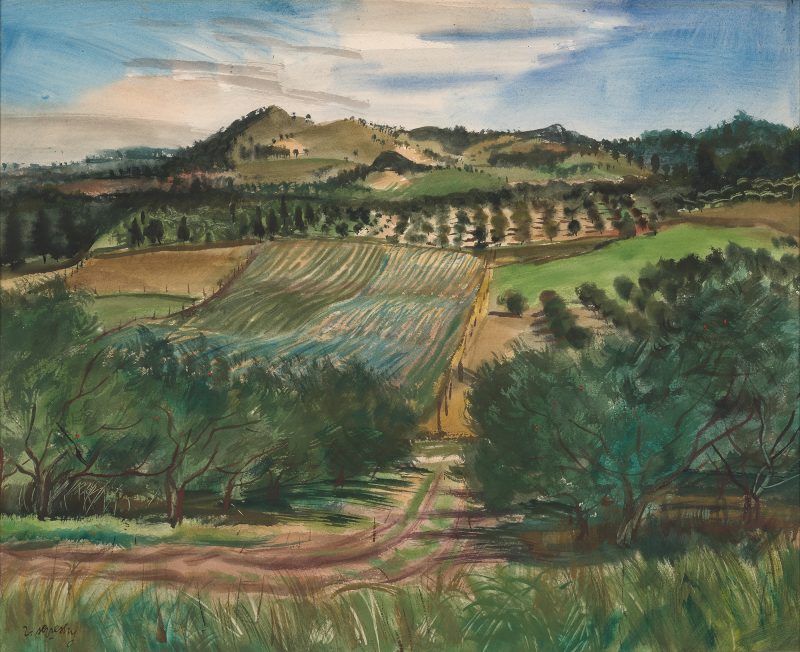
Farmland
Sepeshy, Zoltan L.
1938
Artwork Information
-
Title:
Farmland
-
Artist:
Sepeshy, Zoltan L.
-
Artist Bio:
American, 1898–1974
-
Date:
1938
-
Medium:
Watercolor and ink on paper
-
Dimensions:
17 3/4 x 21 15/16 in.
-
Credit Line:
Wichita Art Museum, Roland P. Murdock Collection
-
Object Number:
M17.41
-
Display:
Not Currently on Display
About the Artwork
Zoltan Sepeshy was born in 1898 in Kassa, Hungary. After graduating from high school, he attended the Royal Academy of Art in Budapest, where he earned Master’s degrees in art and art education. Sepeshy continued his studies in Vienna and Paris and traveled extensively in Germany and Italy.
In 1921 Sepeshy immigrated to the United States. After several months in New York he moved to Detroit to live with his uncle. There, because he spoke no English, Sepeshy was forced to earn a living working in lumberyards and sweeping barbershop floors. Eventually he found work at an advertising agency and an outdoor sign company where he could use his artistic training. During this time, he also painted pictures, which he sold to members of Detroit’s Hungarian community. The patronage of these countrymen enabled Sepeshy to earn enough money to travel west to New Mexico. During the early months of 1922 he lived in Taos and associated with such artists as Ernest Blumenschein, Walter Ufer, and John Sloan.
Soon after Sepeshy returned to Detroit in late 1922 his work began to attract the admiration of art critics. He won first prize in an exhibition of Michigan artists and gained national exposure through a favorable review in the Christian Science Monitor. The local art community quickly noticed Sepeshy’s success and soon he was in demand as a painter and teacher. In 1926 Sepeshy was appointed painting instructor at the newly founded Detroit Society of Arts and Crafts. In 1930 he accepted a position as instructor at the Cranbrook Academy of Art in Bloomfield Hills, Michigan, nineteen miles north of Detroit. He became Cranbrook’s resident-artist in 1933 and in 1947 its director. In 1959 he was given the title of president, which he held until his retirement in 1966. Sepeshy died in Royal Oak, Michigan in 1974.
Sepeshy’s art defies easy classification. He painted still lifes, portraits, and landscapes, with the latter depicting rural, urban, and imaginary scenery. Though his style is predominantly realistic, his oeuvre also includes many works in which the subjects have been distorted and abstracted. Sepeshy assimilated influences from a wide variety of modern artists, including Cezanne, Picasso, Hopper, Benton, Wood, and Dali. Sepeshy purposely worked in different styles and challenged the idea that an artist needed to belong to one specific group. Instead he contended that “art arises from the common needs and aspirations of all men and that compartmentalization is a hindrance to its growth.”1
In Farmland Sepeshy depicts a verdant agrarian landscape in which traces of human presence are suggested by a road in the foreground that leads to a cultivated field and an orchard. Space rises steeply to a high horizon while a row of vegetation delineates the foreground. Sepeshy employs a broad variety of watercolor techniques to define different areas of the painting. Earth colors dominate, expressing the fertility and abundance of the land. Given the fact that Sepeshy often drew direct inspiration from other artists, Farmland may be interpreted as his approving acknowledgement of the accomplishments of Regionalists like Benton and Wood, who, in their work of the 1930s, also celebrated agricultural life in the Midwest.
1. Sepeshy quoted in Laurence Schmeckebier, Zoltan Sepeshy: Forty Years of His Work (Syracuse: The School of Art, Syracuse University, 1966), 33.